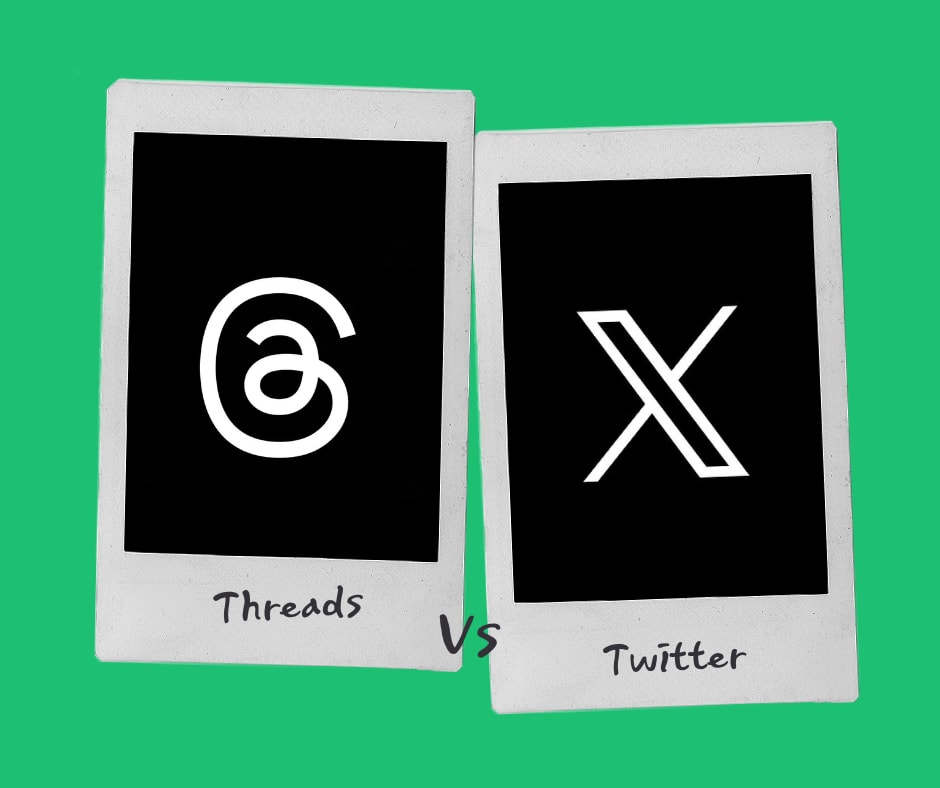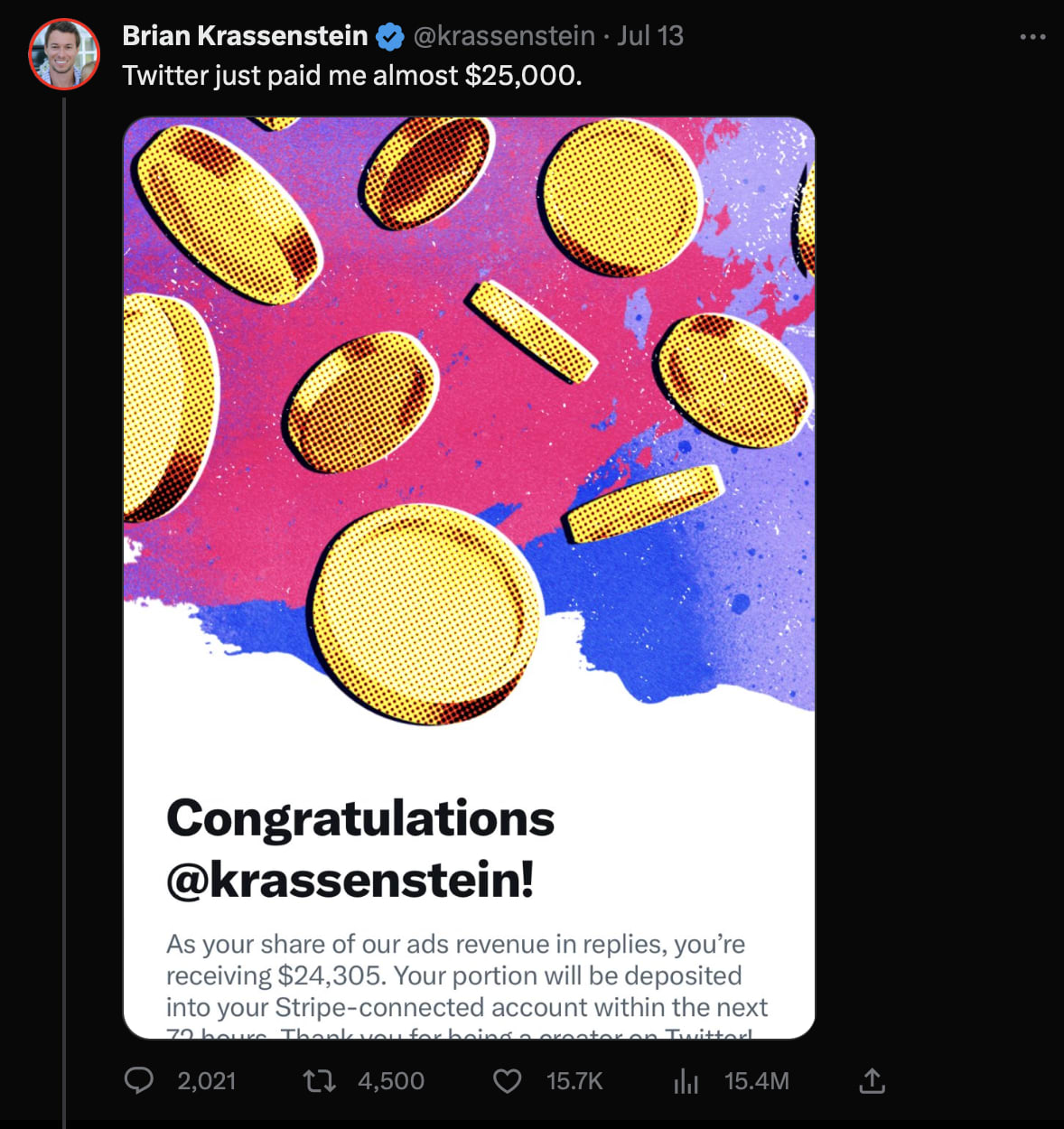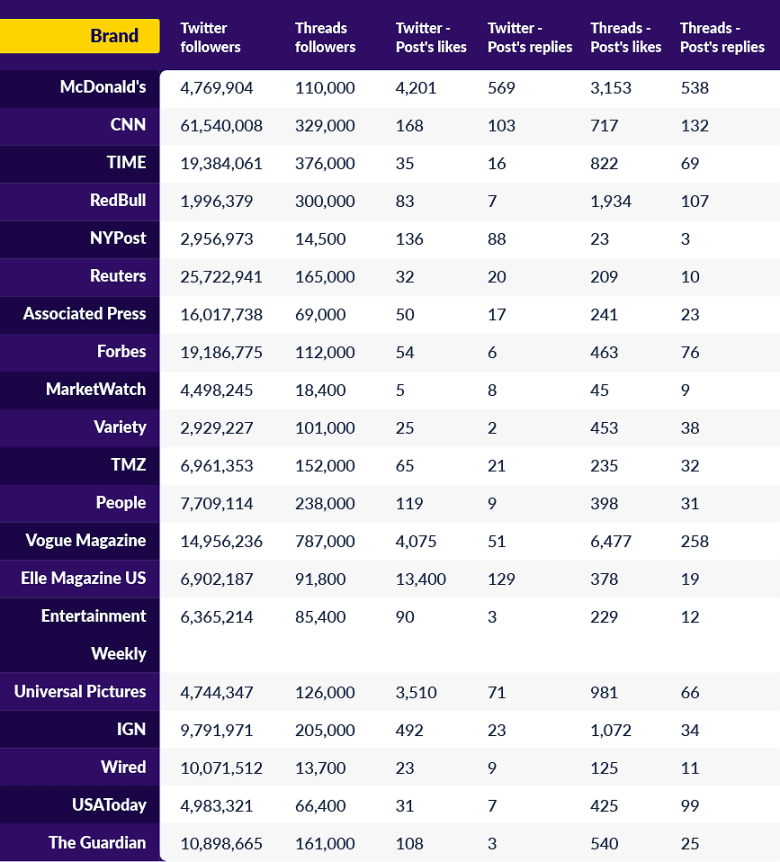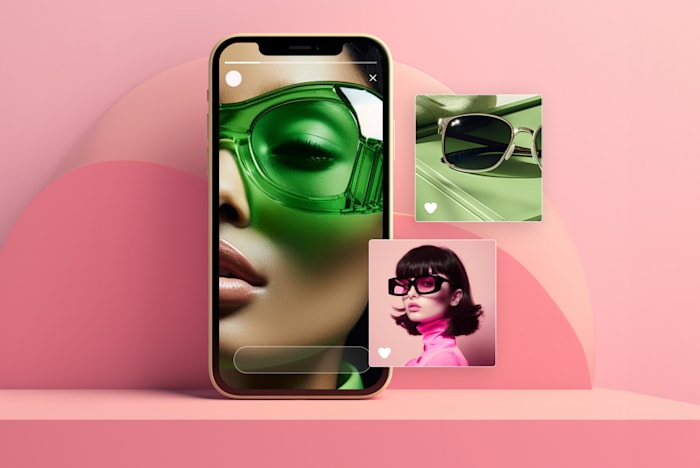Threads vs. Twitter: Which is Best for Your Business?
Not another social platform. Find out if Threads is worth your time or if your business should make the switch.
 August 13, 2023
August 13, 2023 15 minute reading
15 minute reading
Another day, another Twitter copycat.
Mastodon, Bluesky, Hive Social, Spoutible, and Spill, all promise to replace Twitter.
And then there’s Threads, which grabbed over 100 million sign-ups in less than a week.
Advertisers are eagerly watching how Threads develops while brands try to work out how it fits into their current social media strategies. Both want to reach relevant audiences with their content while consistently trying to “find new eyeballs.”
In this guide, we’ll compare Threads vs. Twitter so you can find the platform that aligns best with your needs and engages your audience.
What is Threads and how does it differ from Twitter?

Threads is a new text-based conversation app from Meta, where communities come together to discuss trends and topics they care about. The new app piggybacks off of Instagram to build its user base, and has grabbed over 100 million users in less than a week since Threads’ launch.
“Threads by Meta seems to draw inspiration from both Twitter's layout and Facebook's early interactive dynamics,” says Alexandra Dubakova, head of marketing at Freetour. “It's a bit like stepping back in time to when Facebook was still about deep engagement and discussions, but with a cleaner, Twitter-esque interface.”
The messaging app is described as a Twitter clone because of its format and dynamics. This includes similar features, such as compose, like, share, search, comment, and reply functions.
It’s still early, but let’s explore the key differences between the two platforms—at least initially.
Purpose
Twitter is an online news and social networking site. Some users post short, useful, or interesting messages for their followers, while others use it to receive information or discover and follow celebrities and brands.
The microblogging platform is easy to use, scan-friendly, and offers a stream of quick updates from various sources, including family, friends, companies, experts, and news journalists.
Threads—a Twitter rival app—was designed to take what Instagram does best—connecting people using photos and videos. But the app expands into text so people have a creative and positive space to share text updates, join public conversations, and express their ideas.
Your audience can follow and connect directly with your brand, helping you build a loyal following to share your products, insights, and updates.
Interface

Unlike Twitter, which has desktop and mobile app interfaces, Threads is only available as a mobile app for iOS and Android devices.
You can read threads on the service’s website, but can’t post, like, comment, or repost on the web. This makes Threads an exclusively mobile experience, giving users flexibility for where and how to access their accounts and feeds.
However, Adam Mosseri—Head of Instagram—says the company’s priority is the mobile apps, but they’re working on a web version of Threads app.
“Though not much functionality has been added to Threads yet, it has a more intuitive and streamlined user interface that ensures easy navigation and engagement,” says Sean Lau, travel blogger, LivingOutLau. “Already, Threads provides a more personalized and intimate social media experience, setting it apart from Twitter. When more internet personalities and brands jump onto Threads, Twitter might become obsolete.”
Signup

With Twitter, you can easily sign up independently with the credentials you want or use your Google or Apple account.
When you want to delete your Twitter account, simply deactivate it, and your account is permanently deleted (if you don’t log in during the 30-day deactivation period). There’s no consequence to other social media platforms you might use.
Meta’s Threads is intrinsically linked to Instagram, meaning you’ll need an existing Instagram account to open a Threads profile. You can import important information like your bio, friends, and even your verification badge from Instagram to your Threads profile.
According to Threads’ supplemental privacy policy, you can’t delete your Threads account without deleting your Instagram profile. You can deactivate your Threads account instead, which hides your profile and posts until you reactivate it. This is one reason some Instagram users haven’t signed up for Threads because it seems to hold their Instagram account hostage.
Verification

Before Elon Musk took over Twitter, the platform had verification guidelines like Instagram’s—based on the user’s public standing.
Today, you can pay for a verification badge by subscribing to Twitter Blue. News outlets and certain established organizations get a gold check, while government accounts get a grey check.
Threads carries over a user’s Instagram verification to their Threads profile. If you’re verified on Instagram, you’ll be verified on Threads.
Trending topics
Twitter offers personalized recommendations on its For You tab, plus you can find trending topics in its Explore tab. Threads doesn’t offer this feature yet, but will likely introduce it considering Instagram generates algorithmically picked or trending posts in its Search and Explore tab.
“After closely observing threads since its release last July 5, I've noticed that it thrives on interaction from people who follow you,” says Jerica, PR Specialist atVirtudesk. “The algorithm seems to prioritize trending posts with comments from your followers and similar profiles of those you follow. Like Instagram's algorithm, Threads rely heavily on connections rather than topics. Unless you already have a strong presence and engagement on IG, threads operate similarly.”
Meta says it’ll soon add several new features so Threads users can discover threads and creators they’re interested in. These features include a more robust search function and improved recommendations in the feed, making it easier for people to follow trends and topics in real-time.
Content
Twitter allows users to curate their post feeds and control the content they want to receive.
For example, you can view a “For you” feed, which suggests a variety of posts from accounts you follow, or only view posts from accounts you follow from your “Following” feed. Plus, you can block accounts and mute words to control what you see.
Threads has a singular (non-chronological) feed that pulls a mix of different content from accounts you follow and trending posts—more like a combination of instagram’s main feed and Discover page. You can only block accounts or mute words to control the content you see in your feed.
Twitter also lets you search words or phrases and see all top (relevant) or latest posts based on your search query. Threads only lets you search for accounts, giving Twitter the upper hand as a place to find news or trending topics.
Another major difference is the type of content you can post. Both apps allow you to post images, videos, GIFs, and website links. However, Twitter limits you to four items per tweet, while Threads lets you post 10 items at once. But if you post a GIF, you must save it to your camera roll first.
Threads also uses a highly-intuitive, carousel-like display that lets you swipe sideways to view a collection of photos and videos—something Twitter lacks.
Character count
Threads and Twitter are primarily for sharing short messages, from brand updates and insights to jokes and complaints,relevant to your followers.
Twitter’s free plan has a 280-character limit. Subscribing to Twitter Blue unlocks long-form writing features, up to 10,000 characters, and bold and italic formatting support.
“The character limitation on Twitter has been a significant factor in shaping our content creation and marketing strategies,” says Padmaja Santhanam, partner and general manager of growth at FirstPrinciples Growth Advisory. “However, it's worth mentioning that with the introduction of bloating and increased character limits for verified accounts, the game has changed, allowing for more flexibility in content length. This expansion presents opportunities for us marketers to deliver more comprehensive and engaging content on the platform.”
Threads’ limit is 500 characters, so you can share more and longer on Threads than you would with Twitter’s free tier.
Messaging
Threads and Twitter are both messaging apps, but Twitter provides in-app messaging or a direct messaging (DM) option, while Threads doesn't.
You can communicate with any user on Twitter (depending on their privacy settings) by sending a text, image, voice message, GIF, or simply sharing a tweet.
Threads currently lacks an in-app option to share a Thread, but you can tag the person in the post's comment section or reach out to them via their Instagram DM—which is inconvenient since you have to switch apps.
Engagement

Twitter and Threads share similar features, including:
Compose
Like button
Comment/reply tool
Repost/retweet and quote
Share options
Depending on how you want to engage, you can click on a Tweet or Thread to expand and view the comments, reply to the original message, or directly to another comment.
Twitter has a notifications tab showing who followed or mentioned you, retweeted your post, or engaged with your tweet. You can also see your past likes through the Likes tab on your profile.
Threads uses an Activity tab to show similar information, but it lacks a dedicated Likes tab that displays a running log of posts you liked.
“I notice that I get way more engagement on Twitter than Threads,” says Ashley Mason, founder of Dash of Social. “I also seem to only get engagement on Threads from people I already know, while on Twitter, new people are always seeing and interacting with my content.”
Twitter also offers hashtag support, which Threads currently doesn’t provide. But the company may soon incorporate hashtag support similar to Instagram and Facebook.
Costs
Twitter and Threads are both free to join and use.
However, Twitter reserves some features for paying members of its Twitter Blue subscription tier, such as:
Ability to edit a tweet
Ability to customize the Twitter app icon’s appearance
Longer tweet character limits
Bigger rate limit of tweets you can read daily
Threads has no features hidden behind a paywall or advertisements.The company says it hasn’t hit “critical mass” yet but is working to get its branded content tools up and running. For now, brands can only use text or hashtags to disclose paid partnerships while advertising is still off-limits.
Twitter hosts ads on its platform to generate revenue. The ads appear with a Promoted icon and can be Follower Ads, Promoted Ads, or Trend Takeover, which are visible to all Twitter users—including verified ones.
Monetization
There’s no monetization on Threads right now. This may be a plus for user experience, but having no ad model is a negative for Meta. According to Mosseri, monetization isn’t the company’s focus right now as it’s still trying to build an app people want to keep using before worrying about making money.
Twitter offers various monetization mechanisms and incentives for content creators, such as Amplify Pre-Roll, Tips, and Super follows.
More recently, Twitter introduced an Ads revenue sharing monetization effort, offering creators ad revenue share from the ads served in replies to their Twitter posts. To be eligible, you must be a Twitter Blue subscriber who earned over 5 million tweet impressions per month for the past three months.
Here’s an example from Brian Krassenstein, who recently got a $24,305 payout from Twitter as his share of ads revenue in replies.

Source: Twitter
Meta hasn’t shared whether it’ll bring incentives or monetization mechanisms soon. For now, we’ll wait things out, since Threads is still new, and many creators just carried over their follower lists.
Availability and regulatory concerns
While Twitter is available in most countries, including the European Union (EU), Threads is available in more than 100 countries except the EU.
Threads hasn’t been released in the EU region because of the bloc’s privacy regulations and standards.
In addition, the app’s data privacy operations don’t comply with some laws coming into effect, particularly the EU’s Digital Markets Act. This act defines clear rules governing how large online platforms use their market power. That way, those platforms don’t abuse their “gatekeeping” positions to the detriment of other companies wishing to access such users.
“There are a lot of things that Twitter has that Threads lack, which the latter will refine over time,” says Robert Oates, CEO, Arbtech. “As of now, it isn't available in the EU. Threads will most likely work on many of its problems, but at the moment, I'd say Twitter is the better platform.”
Threads is a standalone app, but still imports a variety of users’ personal data from Instagram. The exact meaning of what’s collected remains murky, but the app potentially collects data like:
Health and financial information
Browsing history
Purchases
Usage Data (product interaction, advertising data, other usage data)
Contact info (physical and email address, name, phone Number, other user contact details)
Identifiers (User ID, device ID)
Search history
Location (precise or coarse)
Sensitive information (could include race, sexual orientation, religion, biometric data, pregnancy status, and more)
Advertising data
The EU forbids such communication between social media platforms. Given Meta makes money from tracking and profiling web users, then selling their attention to advertisers, the upcoming regulatory uncertainty plays into its decision not to launch in the EU market right now.
Twitter asks for similar information as Threads, keeping plenty of data linked to users to track them. But Twitter doesn’t list “sensitive information” among its disclosed data collection categories.
How might the Threads vs. Twitter competition shape audience engagement?
Unlike Elon Musk’s Twitter, which plans to focus on video, creator, and commerce partnerships, Meta CEO Mark Zuckerberg says Threads’ focus is on improving basics and retention.
Thanks to data and scale, Threads appears to have a leg up on other Twitter dupes. Meta has more than 3 billion users across Facebook, Instagram, and WhatsApp, making it easy for existing users to start new accounts.
Twitter had over 386 million active monthly users worldwide at the end of 2022. But the more abrupt and unpopular changes Musk rolls out on the platform, the more unstable it grows, sparking a host of challengers—including Threads—vying for its coveted throne.
Meta’s goal isn’t to replace Twitter. Sure, hard news and politics will inevitably show up on Threads, but the company won’t actively encourage those verticals. And Threads might not instantly capture Twitter’s cultural cachet, but it could end up being the place people go for a conversation-based platform.
“Threads appears like a mirror image of Twitter, with its own slight variations,” says John Cammidge, PPC expert at JCammidge. “Yet, in the grand chronicle of social media, echoes of past endeavors, such as Google+, loom large. It reminds us that the critical determinant of a platform's success is not its feature set alone, but rather, the community it cultivates and the engagement it elicits.”
Meta still has a lot of work to do, but early data for brands on Threads shows good engagement.
It’s way too early to measure what you can expect from initial usage insights, but Threads’ first returns look promising for brand engagement.
A study by Website Planet, which surveyed posts from 30 brands with Threads and Twitter accounts, shows:
Majority of brands active on Threads generate more likes per post than on Twitter.
Overall average number of likes sits around 8 times their normal tweet engagement.

Source: Website Planet
This shows brand profiles generate good engagement in Threads—a good predictor of growth and future potential.
Threads has less than half of Twitter’s user base, meaning there are fewer people to engage and lower competition for attention.
So far, influential people—including 103 heads of state—activated Threads accounts. Large corporate brands, including Microsoft, Netflix, McDonald’s, the NBA, PlayStation, and the BBC have also set up shop on Threads, boding well for broader adoption, sustained interest in the platform, and future growth potential. Entertainment-focused companies and newspapers have also signed up and are posting avidly on Threads.
However, Sensor Tower—a market intelligence firm—reports relatively low engagement in Threads, with time spent declining by 60%. The report also shows a nearly 70% decline in daily active users from the app’s initial launch highs and lower overall user engagement than time spent on Instagram or Twitter.
That said, Threads is still in its infancy, meaning there are too many factors to make real conclusions. But Threads has many opportunities to maximize user demand and become the next big social app, particularly if it taps into a range of elements like reach, functional improvements, moderation, and more.
The Threads team already outlined key updates coming to the app, such as a following feed, edit button, post search, and more. For now, it’s not a place to be heavily promotional, so brands and businesses should consider this when creating a social media marketing strategy on Threads.
“In Threads' case, a surface comparison with Twitter may yield a "copycat" label, but this viewpoint could be a tad reductive,” says Cammidge. “Twitter's provenance and entrenched user base provide it a firm footing, but Threads, like any new platform, has the potential to carve out its own niche, given the right user experience and community engagement. However, as we've learned from other platforms, it's all too easy to burst onto the scene with a bang, only to fade into obscurity. Therefore, the litmus test for Threads will not be its launch or the initial flurry of activity."
Key takeaways when deciding between Threads vs. Twitter
It’s unclear how “sticky” Threads will be to businesses.
Small businesses strapped for time, often focus their efforts on platforms that are already effective for their audiences and brands. So, dumping their energies on Threads might not yield returns. In this case, you’ll need to make calculated choices about where to invest your money and time.
You don’t have to rush to join Threads. It’s a new social media platform, so much of what you see now can change quickly.
It may be easy to assume Threads is just another ‘Twitter Killer’ or a new app that’ll quickly rise and fall. But Threads comes backed by the power of a large, pre-established audience. And with people signing up fast, you’ll need to set up shop where your customers are.
Here are questions to ask yourself when deciding to add Threads to your social media campaign mix:
What benefits has Twitter brought to your business?
In the last six months, has your company’s experience on Twitter been better or worse?
Could your business benefit from a Twitter alternative?
Does your business already use Instagram?
Will joining Threads give you an early adopter advantage and solid organic reach?
Do you have sufficient time, attention, and effort to constantly engage your audience on Threads?
Will you keep the content on Threads updated?
Do you or your team have the capacity to resource Threads alongside other content marketing tools and platforms?
Is your company a brand builder, or is it more sales-oriented?
Does social media already drive a lot of your business?
Are you anxious about how Threads’ rules will evolve and impact your reach, engagement, position, and other things your business relies on?
At this point, it’s critical to pay attention to Threads and consider how it might fit into your content strategy and social media calendar. You may not get all the features Twitter offers, like paid ads and direct messages, but you can set up a personal Threads account to test-run the app and see how it evolves while tracking your competitors’ actions.
You can leverage artificial intelligence (AI) content creation tools for your social media strategy. Or, find a social media strategist to create the best strategy for your business, a social media marketing planner to manage your Threads profile, and even engage with people beyond your original audience.
When you’re willing to engage on Threads, you can define how people will interact with your business on the platform. Get creative and consider how you’ll offer unique value on the new platform while managing your existing Twitter audience.
“As of now, I'll use Twitter more for my brand, which could change in the future,” says Mason. “Threads is still too new to jump ship from Twitter completely, as there are a handful of quirks that need to be figured out on the platform. I also have an active and engaged following on Twitter, but I'm not quite there yet on Threads. Once Threads allows for social media analytics, a desktop version, and scheduling posts, I may change my mind!”
Stay ahead of the game
There’s no right or wrong decision about choosing between Threads vs Twitter.
For content creators, marketers, and businesses, the biggest challenge of adding another activity into your social media mix is getting distracted from your core activities. You or your team may already be overworked, or you’re struggling to find qualified and talented employees to manage a whole new platform.
That’s where Fiverr comes in. The leading digital marketplace hosts expert social media marketers with the skills you need to manage your business’s Threads or Twitter profiles. And you can manage your projects, freelancers, and payments for free.
Sign up to Fiverr to find and hire social media talent for your business today.



